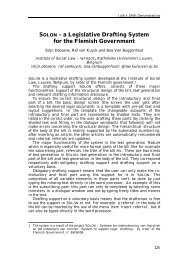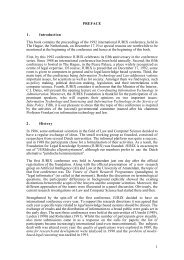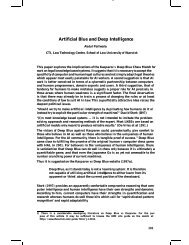On automatic causal reasoning for legal analysis - Jurix
On automatic causal reasoning for legal analysis - Jurix
On automatic causal reasoning for legal analysis - Jurix
You also want an ePaper? Increase the reach of your titles
YUMPU automatically turns print PDFs into web optimized ePapers that Google loves.
META-LEGAL KNOWLEDGE<br />
<strong>legal</strong>ly qualified<br />
situation<br />
agent(s) that caused<br />
the situation<br />
CAUSAL KNOWLEDGE<br />
NORMATIVE<br />
KNOWLEDGE<br />
RESPONSIBILITY<br />
KNOWLEDGE<br />
LAM<br />
classified<br />
situation<br />
agent(s) that<br />
are responsible<br />
CREATIVE<br />
KNOWLEDGE<br />
REACTIVE<br />
KNOWLEDGE<br />
<strong>legal</strong><br />
reaction<br />
DEFINITIONAL KNOWLEDGE<br />
abstract <strong>legal</strong> agency<br />
LEGAL<br />
SYSTEM<br />
COMMON SENSE<br />
KNOWLEDGE<br />
real world<br />
situation<br />
UNIVERSITY<br />
OF AMSTERDAM<br />
MINISTRY OF<br />
EDUCATION<br />
SOCIETY<br />
)LJXUH The Functional <strong>On</strong>tology of Law<br />
FOLaw tries to capture and to <strong>for</strong>malize both the internal structure and the functioning of a<br />
<strong>legal</strong> system. It relies on two main (modeling) assumptions:<br />
• Legal knowledge can be “modularly” represented, i.e. a legislation consists of different<br />
categories of knowledge which can be distinguished from each other;<br />
• Legal knowledge can be functionally represented, i.e. the different modules fulfil<br />
different functions both within the <strong>legal</strong> system and in the <strong>analysis</strong> of a single case.<br />
Figure 1 (from [11], p.74) shows the different categories of <strong>legal</strong> knowledge that Valente has<br />
“isolated” and their functional dependencies. These dependencies <strong>for</strong>m the typical structure<br />
of <strong>legal</strong> argument, which can, <strong>for</strong> instance, be executed as a series of steps in assessing a <strong>legal</strong><br />
case (but the same structure may also support the drafting of legislation).<br />
Our main objectives have so far been the LQGLYLGXDWLRQ and the GHILQLWLRQ of <strong>causal</strong><br />
knowledge. We follow a rather broad and qualitative method of research: conceptual <strong>analysis</strong>.<br />
This is due to three main factors: the QDWXUH RI WKH WUHDWHG VXEMHFW (i.e., <strong>legal</strong> <strong>causal</strong><br />
<strong>reasoning</strong>), which is an argumentative kind of activity, definitely based on a qualitative image<br />
of the world; the need of H[SDQGLQJDQRQWRORJ\, which is defined as the specification of a<br />
conceptualization; and the VHHNIRUJHQHUDOLW\.<br />
The present article offers an overview of the set-up of our research project. Section 2<br />
contains a counter-argument against the undermined role of causation in <strong>legal</strong> theory.<br />
Furthermore it gives an overview of the most relevant <strong>legal</strong> theoretical approaches to the<br />
problem. Based on such overview we choose Hart and Honoré’s account [5] as our<br />
jurisprudential guideline. Section 3 briefly goes into the fields of philosophy and artificial<br />
intelligence, where we actually stayed a long time in search of inspiring theories. <strong>On</strong>e of<br />
these is Pearl’s inferential framework, which we adopt as computational support <strong>for</strong><br />
counterfactual <strong>reasoning</strong>. Finally, Section 4 shows the problems we are currently dealing<br />
with, in the attempt at merging Hart and Honoré’s qualitative account of causation and<br />
Pearl’s <strong>for</strong>mal theory of <strong>causal</strong>ity.






